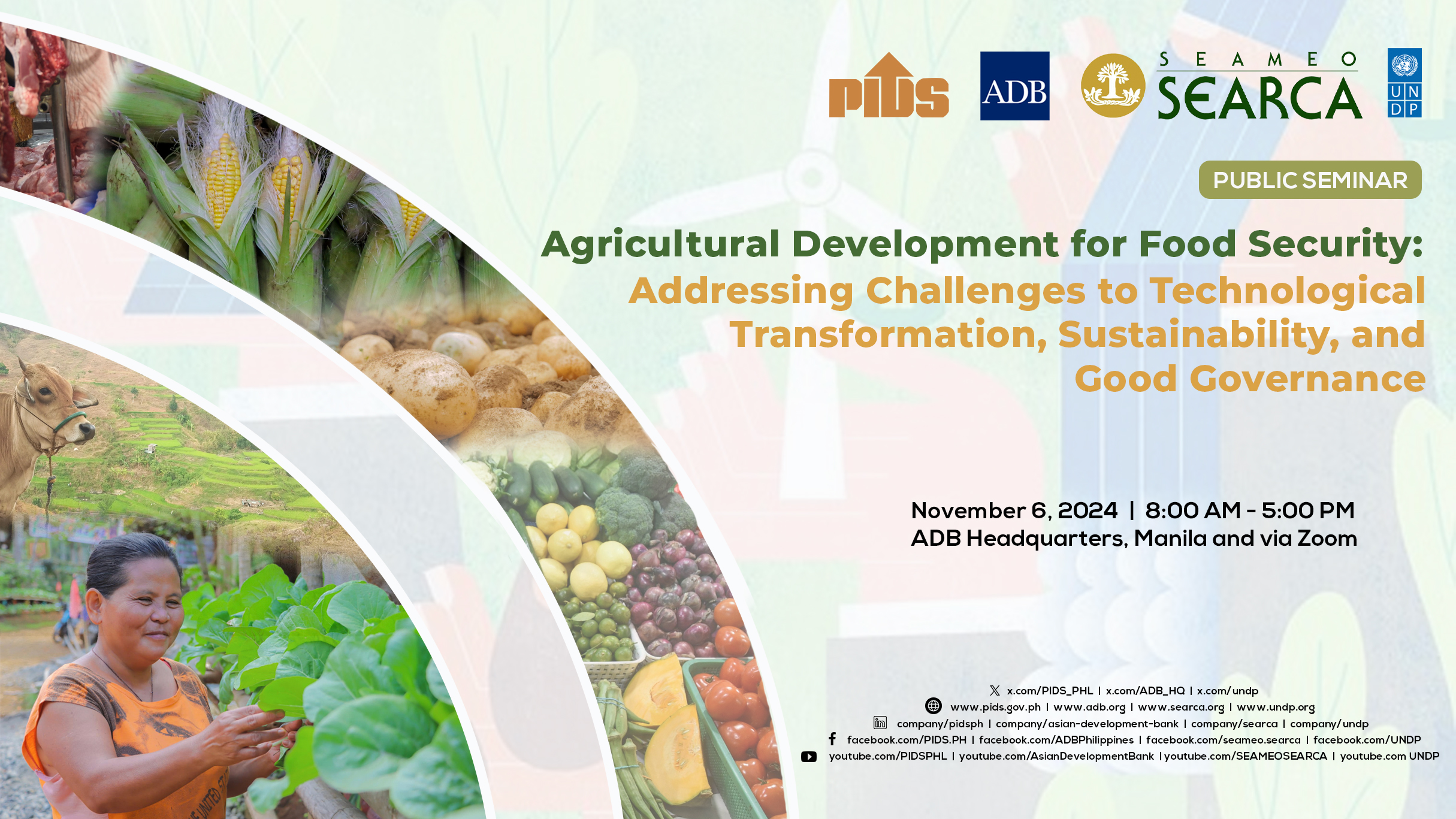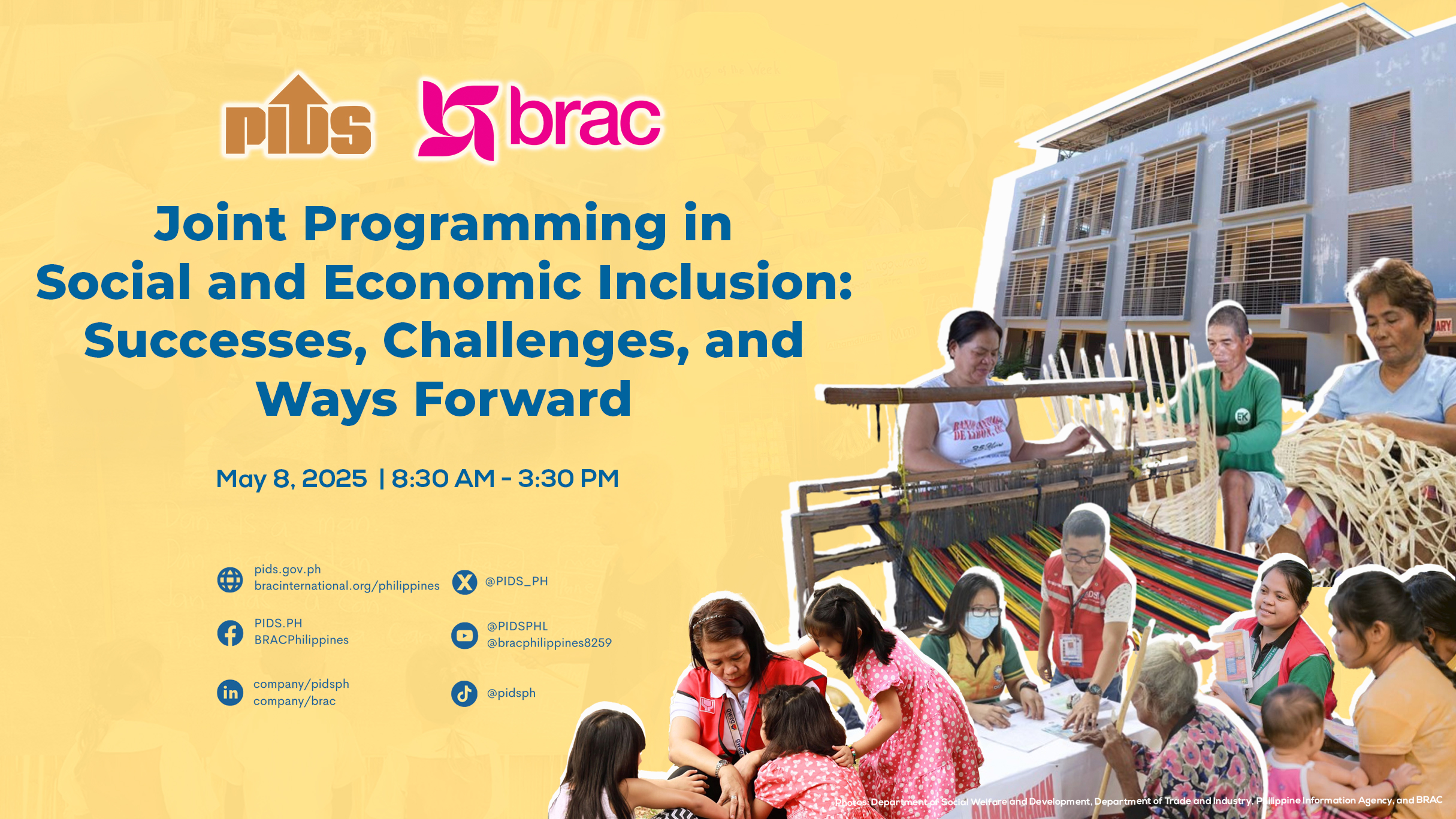MORE than half of the labor force, particularly those between 15 to 59 years old, are not social security members, according to a study released by the Philippine Institute for Development Studies (PIDS).
In a recent presentation, PIDS Research Fellow Aubrey D. Tabuga said 26.246 million aged 15 to 59 years old are not members of either the Social Security System (SSS) or Government Service Insurance System and PhilHealth.
Tabuga said this represented 56 percent of total labor force using 2017 data, and majority of these Filipinos are women.
“In a much broader sense, all efforts for achieving income security, enhancing agricultural productivity and off-farm income opportunities in the rural areas, and facilitating innovative work schemes that are inclusive of women are all consistent with initiatives for improving access to social insurance,” Tabuga said in her recommendations.
Based on the data, more than half or 52 percent of nonmembers of SSS/GSIS and PhilHealth are women. This meant around 13.095 million are women.
This includes 6.678 million women who are not in the labor force, usually due to domestic responsibilities; 6.417 million who are employed and 478,000 who are unemployed.
The data showed that men account for 48 percent or a total of 12.673 million of nonmembers of SSS/GSIS and PhilHealth. This is composed of 10.621 million employed; 1.174 million not in the labor force; and 878,000 who were unemployed.
“In total, there were at least 26 million persons aged 15 to 59 who are nonmembers. And this represents 56 percent of the population of interest. Note that this figure does not include those economically active persons who were currently in school. So we did not include those,” Tabuga explained.
The study also found that among the 15 to 59 year olds who were employed and nonmembers of SSS/GSIS and PhilHealth, there were relatively more males who belong to bottom 30 percent or poorest households.
Data showed 42 percent of these workers were male while 36 percent were female. Majority of men who are in this category were either working without pay in family-owned enterprises at 54 percent or self-employed at 49 percent.
However, Tabuga said 31 percent of male and 31 percent of female workers who are employed in government are both nonmembers of SSS/GSIS and PhilHealth as well as belong to the bottom 30 percent of households.
Men paid higher
Meanwhile, the data showed, the average daily basic pay of men is higher than women among workers in private establishments. The average daily basic pay for men is P264 while for women, it is 27 percent lower at P192.
Among the self-employed, more men were working in the agriculture sector while for women, more are working in small retail businesses and personal services such as those working in spas.
“Self-employed women wanted more work, wanted more hours of work than other categories of female workers which suggest that they want to augment their earnings,” Tabuga said.
Among unpaid family workers, majority are engaged in agricultural activities, 88 percent for men and 80 percent for women. Around 75 percent of men and 69 percent are women are crop farm laborers.
Tabuga noted that 9 out of 10 of the males who are unpaid family workers are single and young, with average age at 23 years old. Only 27 percent of women are single and were older, with an average age of 25 years old.
In terms of the government workers, more women hold permanent positions but most are being paid on commission basis. Over 20 percent of men and women are also working in other jobs.
“So even among government workers, the issue seems to be the nature of the employment as well as inadequate earnings as suggested by their profiles,” Tabuga said.
Insurance gaps
With these data, Tabuga said some of the key issues for expanding insurance coverage includes the lack of income security due to the unstable and casual nature of their employment.
This discourages them from enrolling and sustaining their membership. Many of the unpaid family workers are in agriculture, may be less productive and therefore also have less income.
Tabuga sees this as proof that improving agricultural productivity and off-farm opportunities in rural areas can help boost both women’s and men’s ability to access social insurance.
She also saw a lack of enforcement or implementation of the law in providing access to social insurance for workers in private establishments and private households.
Ditto a lack of awareness and low level of perception on the benefits of social insurance. Tabuga said administrative hurdles in enrollment and payment or collection of contributions may account for this.
Meanwhile, she said, the early dropout of older boys from school to seek jobs or become unpaid workers in farms is an economic issue needing appropriate solutions.
“The high rate of economic inactiveness is largely a gender issue which emanates from traditional roles of women in the home, Tabuga said. The high rate of women who are neither in school nor at work, “and early marriages and teenage pregnancies are also areas for concern,” according to her.
Apart from recommendations to maximize efforts to boost incomes and enforce labor laws, Tabuga said both national and local governments must conduct a wide advocacy campaign for promoting awareness and need for social insurance.
She encouraged government to partner with various organizations and platforms, including online venues in motivating people to be more proactive with social insurance.
Tabuga also said insurance providers, SSS and PhilHealth, must also take a more active role in the information and education campaign. Ordinary citizens must understand the importance of social insurance.
In a recent presentation, PIDS Research Fellow Aubrey D. Tabuga said 26.246 million aged 15 to 59 years old are not members of either the Social Security System (SSS) or Government Service Insurance System and PhilHealth.
Tabuga said this represented 56 percent of total labor force using 2017 data, and majority of these Filipinos are women.
“In a much broader sense, all efforts for achieving income security, enhancing agricultural productivity and off-farm income opportunities in the rural areas, and facilitating innovative work schemes that are inclusive of women are all consistent with initiatives for improving access to social insurance,” Tabuga said in her recommendations.
Based on the data, more than half or 52 percent of nonmembers of SSS/GSIS and PhilHealth are women. This meant around 13.095 million are women.
This includes 6.678 million women who are not in the labor force, usually due to domestic responsibilities; 6.417 million who are employed and 478,000 who are unemployed.
The data showed that men account for 48 percent or a total of 12.673 million of nonmembers of SSS/GSIS and PhilHealth. This is composed of 10.621 million employed; 1.174 million not in the labor force; and 878,000 who were unemployed.
“In total, there were at least 26 million persons aged 15 to 59 who are nonmembers. And this represents 56 percent of the population of interest. Note that this figure does not include those economically active persons who were currently in school. So we did not include those,” Tabuga explained.
The study also found that among the 15 to 59 year olds who were employed and nonmembers of SSS/GSIS and PhilHealth, there were relatively more males who belong to bottom 30 percent or poorest households.
Data showed 42 percent of these workers were male while 36 percent were female. Majority of men who are in this category were either working without pay in family-owned enterprises at 54 percent or self-employed at 49 percent.
However, Tabuga said 31 percent of male and 31 percent of female workers who are employed in government are both nonmembers of SSS/GSIS and PhilHealth as well as belong to the bottom 30 percent of households.
Men paid higher
Meanwhile, the data showed, the average daily basic pay of men is higher than women among workers in private establishments. The average daily basic pay for men is P264 while for women, it is 27 percent lower at P192.
Among the self-employed, more men were working in the agriculture sector while for women, more are working in small retail businesses and personal services such as those working in spas.
“Self-employed women wanted more work, wanted more hours of work than other categories of female workers which suggest that they want to augment their earnings,” Tabuga said.
Among unpaid family workers, majority are engaged in agricultural activities, 88 percent for men and 80 percent for women. Around 75 percent of men and 69 percent are women are crop farm laborers.
Tabuga noted that 9 out of 10 of the males who are unpaid family workers are single and young, with average age at 23 years old. Only 27 percent of women are single and were older, with an average age of 25 years old.
In terms of the government workers, more women hold permanent positions but most are being paid on commission basis. Over 20 percent of men and women are also working in other jobs.
“So even among government workers, the issue seems to be the nature of the employment as well as inadequate earnings as suggested by their profiles,” Tabuga said.
Insurance gaps
With these data, Tabuga said some of the key issues for expanding insurance coverage includes the lack of income security due to the unstable and casual nature of their employment.
This discourages them from enrolling and sustaining their membership. Many of the unpaid family workers are in agriculture, may be less productive and therefore also have less income.
Tabuga sees this as proof that improving agricultural productivity and off-farm opportunities in rural areas can help boost both women’s and men’s ability to access social insurance.
She also saw a lack of enforcement or implementation of the law in providing access to social insurance for workers in private establishments and private households.
Ditto a lack of awareness and low level of perception on the benefits of social insurance. Tabuga said administrative hurdles in enrollment and payment or collection of contributions may account for this.
Meanwhile, she said, the early dropout of older boys from school to seek jobs or become unpaid workers in farms is an economic issue needing appropriate solutions.
“The high rate of economic inactiveness is largely a gender issue which emanates from traditional roles of women in the home, Tabuga said. The high rate of women who are neither in school nor at work, “and early marriages and teenage pregnancies are also areas for concern,” according to her.
Apart from recommendations to maximize efforts to boost incomes and enforce labor laws, Tabuga said both national and local governments must conduct a wide advocacy campaign for promoting awareness and need for social insurance.
She encouraged government to partner with various organizations and platforms, including online venues in motivating people to be more proactive with social insurance.
Tabuga also said insurance providers, SSS and PhilHealth, must also take a more active role in the information and education campaign. Ordinary citizens must understand the importance of social insurance.












